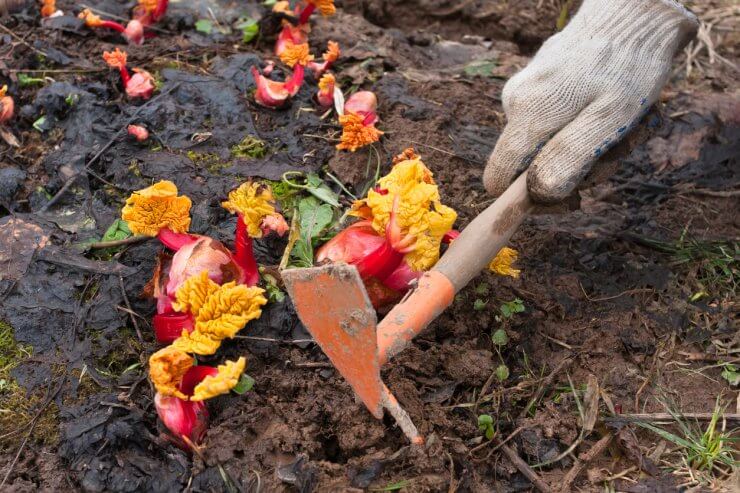
Gardener weeding garden bed with rhubarb
Water
Once your rhubarb plants are settled in—whether it’s in a container, a raised bed, or open ground—consistency is key when it comes to watering. If you don’t get rain on a regular basis, go out and give your rhubarb a good drink of water. Rhubarb like soil that’s moist, but not soggy. Don’t kill your rhubarb plants with kindness. Water, yes—just not too much.
In general, you’ll want to water deeply about once a week, so your plants get about an inch of water. If the top of the soil is a little dry, that’s OK. But don’t let the soil dry out. Lay down a layer of mulch to help retain moisture; ground-up leaves, clean grass clippings (no pesticides), or compost work well.
It’s always best to water in the morning, so your plants can soak up the water and put it to work. Watering earlier in the day also gives the sun time to burn off any water on the leaves. When you do water, aim for the base of the plant. Try not to get the leaves wet (unless you’re blasting off pests); that can open the plant to fungal infection.
Weeding
If you’ve planted in raised beds or containers, weeds shouldn’t be much of a problem. If you do see weeds, pull them early and often—but be gentle about it. Loosen the soil gently around your plants, especially when they’re young, so you don’t disturb their roots. For raised beds and containers, this is another good reason to get yourself some fresh garden soil; it’s one less piece of aggravation to deal with during the growing season.
One good protection against weeds is to lay down a layer of mulch. Wood chip mulch is especially effective on several fronts: it deters weed growth, it helps retain soil moisture, and as the wood chips break down over time, they release nutrients into the soil.
But even if you’re growing your rhubarb directly in the ground, properly preparing your soil is still an excellent preventive measure against the emergence of weeds. When you till or cultivate the area where you’ll plant your rhubarb, remove weeds and debris. You’ll likely find that the first few weeks after planting are the only time you’ll be pulling up weeds around your plants. Of course, there’s nothing to say you can’t amend your garden bed with a little commercially available garden soil. Give your rhubarb all the advantages you can to ensure a healthy crop.
If weeds spring up around your rhubarb during the growing season, work the soil around the base of the plants with a hand rake—only deep enough to kill the weeds and not damage the plant’s roots.
Fertilizer
Rhubarb is a perennial, so it needs a little TLC year-round. The key times for fertilizing are spring and fall.
In the spring, they need a good nitrogen-rich fertilizer to encourage new leaf growth. In the fall, when the plant is preparing to go dormant, give your rhubarb a phosphorous-rich fertilizer—blood meal or an all-purpose fertilizer. This will help the plant establish its root base when the plant is young, and support root health as the plant grows from year to year.
If you feel your rhubarb plants aren’t flourishing, you can apply any good vegetable fertilizer. Just be sure to follow the application directions.
How often do you have to fertilize or water your rhubarb? Do you have any particular challenges growing rhubarb? Please tell us your tips for nurturing healthy rhubarb.


 Previous
Previous

